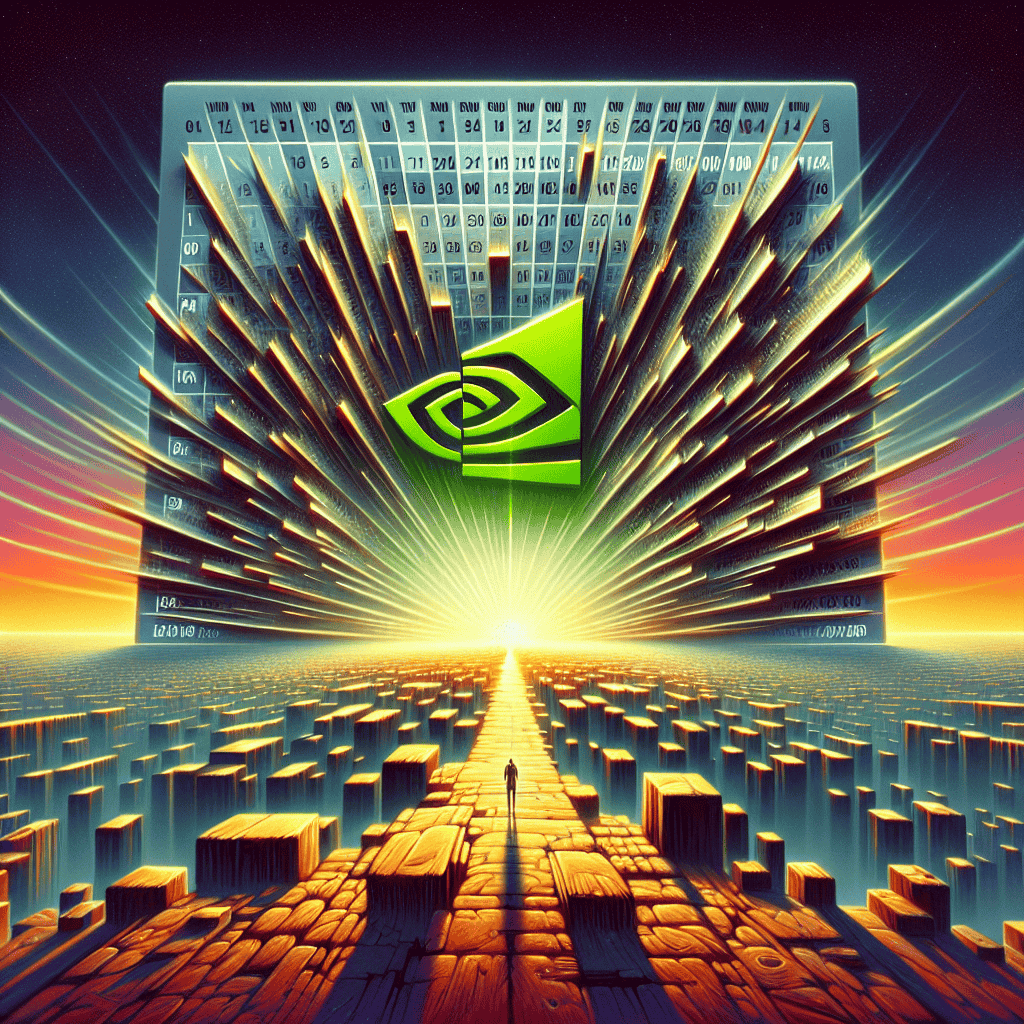“Nvidia Braces for Impact: Strategic Moves Now Could Shape Future Success”
Introduction
Nvidia, a leading player in the semiconductor industry, is approaching a pivotal week that could significantly impact its market trajectory, even though its next earnings report is still a month away. The company, renowned for its cutting-edge graphics processing units (GPUs) and advancements in artificial intelligence (AI) technology, is navigating a landscape filled with both opportunities and challenges. Key developments in the tech sector, potential regulatory changes, and shifts in global supply chains are converging to create a critical juncture for Nvidia. Investors and analysts are closely monitoring these factors, as they could influence Nvidia’s strategic decisions and market performance in the near term. As the company prepares to address these dynamics, the upcoming week may offer crucial insights into its future direction and resilience in a rapidly evolving industry.
Nvidia’s Strategic Moves: Preparing for the Upcoming Earnings Season
Nvidia, a leading player in the semiconductor industry, is poised for a pivotal week as it navigates the complex landscape of technological innovation and market dynamics. Although the company’s earnings report is still a month away, the strategic decisions made in the coming days could significantly influence investor sentiment and market performance. As Nvidia continues to solidify its position in the artificial intelligence and gaming sectors, the anticipation surrounding its upcoming earnings season is palpable.
To begin with, Nvidia’s recent advancements in AI technology have captured the attention of both industry experts and investors. The company’s GPUs are renowned for their ability to accelerate machine learning tasks, making them indispensable in the development of AI applications. As AI continues to permeate various industries, Nvidia’s role as a key enabler of this technology cannot be overstated. This week, the company is expected to unveil new partnerships and collaborations that could further enhance its AI capabilities. Such strategic alliances are crucial as they not only expand Nvidia’s technological prowess but also open new revenue streams, thereby setting the stage for a robust earnings report.
In addition to its AI endeavors, Nvidia’s influence in the gaming industry remains a cornerstone of its business model. The company’s graphics cards are highly sought after by gamers worldwide, and any developments in this sector are closely monitored by stakeholders. This week, Nvidia is anticipated to make announcements related to its gaming division, potentially introducing new products or updates that could drive consumer interest and sales. As the gaming industry continues to grow, fueled by advancements in virtual reality and immersive experiences, Nvidia’s ability to innovate and meet consumer demands will be critical in maintaining its competitive edge.
Moreover, Nvidia’s strategic maneuvers in the data center market are also under scrutiny. The demand for data processing and storage solutions is escalating, driven by the exponential growth of data generated by businesses and consumers alike. Nvidia’s GPUs are increasingly being utilized in data centers to enhance computational efficiency and reduce energy consumption. This week, the company may reveal new initiatives aimed at strengthening its foothold in this lucrative market. By doing so, Nvidia not only diversifies its revenue base but also positions itself as a leader in sustainable technology solutions.
While Nvidia’s technological advancements are impressive, the company must also navigate external challenges that could impact its performance. Geopolitical tensions and supply chain disruptions remain persistent threats to the semiconductor industry. Nvidia’s ability to mitigate these risks through strategic sourcing and operational resilience will be closely watched by analysts and investors. This week, any announcements related to supply chain strategies or geopolitical risk management could provide valuable insights into the company’s preparedness for potential disruptions.
In conclusion, Nvidia faces a crucial week ahead as it prepares for the upcoming earnings season. The company’s strategic moves in AI, gaming, and data centers will be instrumental in shaping its financial outlook. As investors and industry observers keenly await Nvidia’s next steps, the decisions made in the coming days could have far-reaching implications for the company’s future. By leveraging its technological expertise and navigating external challenges, Nvidia aims to reinforce its position as a leader in the semiconductor industry, setting the stage for a promising earnings report next month.
Market Speculations: How Nvidia’s Stock is Reacting Ahead of Earnings
Nvidia, a leading player in the semiconductor industry, is poised for a pivotal week as market speculations intensify, despite its earnings report being a month away. Investors and analysts alike are closely monitoring the company’s stock movements, as Nvidia’s performance often serves as a bellwether for the broader technology sector. This anticipation is fueled by a combination of factors, including recent market trends, technological advancements, and geopolitical influences, all of which contribute to the heightened scrutiny of Nvidia’s stock.
To begin with, Nvidia’s stock has been on a remarkable trajectory over the past year, driven by its dominance in the graphics processing unit (GPU) market and its strategic expansion into artificial intelligence (AI) and data center solutions. The company’s GPUs are not only essential for gaming but also for AI applications, which have seen exponential growth. This dual demand has positioned Nvidia as a critical player in the tech industry, and any fluctuations in its stock are closely watched by investors seeking to gauge the health of the sector.
Moreover, the anticipation surrounding Nvidia’s upcoming earnings report is amplified by the broader market context. The semiconductor industry has been grappling with supply chain disruptions and chip shortages, which have affected production timelines and pricing strategies. Nvidia, however, has managed to navigate these challenges relatively well, maintaining robust sales figures and expanding its market share. This resilience has bolstered investor confidence, yet it also raises questions about the sustainability of such performance in the face of ongoing supply chain issues.
In addition to these industry-specific factors, Nvidia’s stock is also influenced by macroeconomic conditions and geopolitical developments. The ongoing trade tensions between the United States and China, for instance, have implications for Nvidia’s operations and supply chains. As a company with significant exposure to international markets, Nvidia must adeptly manage these geopolitical risks to maintain its competitive edge. Consequently, investors are keenly observing how these external factors might impact Nvidia’s financial outlook and stock performance.
Furthermore, Nvidia’s strategic initiatives and product launches are pivotal in shaping market expectations. The company’s recent foray into the automotive sector, with its advanced AI-driven solutions for autonomous vehicles, has generated considerable interest. This diversification strategy not only opens new revenue streams but also positions Nvidia at the forefront of technological innovation. As such, any announcements or developments in this area are likely to influence investor sentiment and, by extension, the company’s stock price.
As the week unfolds, market participants will be closely analyzing Nvidia’s stock movements, looking for any signals that might indicate the company’s future performance. Technical indicators, such as trading volumes and price patterns, will be scrutinized alongside fundamental analyses of Nvidia’s business operations and strategic direction. This comprehensive approach allows investors to make informed decisions, balancing short-term market reactions with long-term growth prospects.
In conclusion, Nvidia faces a crucial week ahead, with its stock performance under the microscope despite earnings being a month away. The interplay of industry dynamics, macroeconomic factors, and strategic initiatives creates a complex landscape for investors to navigate. As Nvidia continues to innovate and expand its market presence, its stock will remain a focal point for those seeking insights into the broader technology sector. Through careful analysis and consideration of various influencing factors, investors aim to anticipate Nvidia’s trajectory and capitalize on potential opportunities in the ever-evolving market.
Key Challenges Nvidia Faces in the Coming Weeks
Nvidia, a leading player in the semiconductor industry, is approaching a pivotal week that could significantly influence its market trajectory, even though its earnings report is still a month away. The company, renowned for its cutting-edge graphics processing units (GPUs) and artificial intelligence (AI) capabilities, is navigating a complex landscape marked by both opportunities and challenges. As the global demand for advanced computing solutions continues to surge, Nvidia finds itself at a crossroads where strategic decisions made in the coming days could have long-lasting implications.
One of the primary challenges Nvidia faces is the ongoing global semiconductor shortage, which has disrupted supply chains across various industries. This shortage has not only affected Nvidia’s ability to meet the burgeoning demand for its products but has also intensified competition among tech giants vying for limited resources. Consequently, Nvidia must carefully manage its supply chain to ensure that it can deliver its products on time while maintaining quality standards. This task is further complicated by geopolitical tensions, particularly between the United States and China, which could impact the availability of critical components.
In addition to supply chain issues, Nvidia is also contending with regulatory scrutiny. The company’s proposed acquisition of Arm Holdings, a British semiconductor and software design company, has attracted attention from antitrust regulators worldwide. This acquisition, valued at $40 billion, is seen as a strategic move to bolster Nvidia’s position in the AI and data center markets. However, regulatory bodies in the United States, the European Union, and the United Kingdom have expressed concerns about potential anti-competitive effects. As Nvidia navigates these regulatory hurdles, the outcome of this acquisition could significantly shape its future growth prospects.
Moreover, Nvidia is facing increasing competition from other tech giants, such as AMD and Intel, which are aggressively expanding their presence in the GPU and AI markets. These competitors are investing heavily in research and development to close the technological gap with Nvidia, which has long been considered the industry leader. To maintain its competitive edge, Nvidia must continue to innovate and deliver products that meet the evolving needs of its customers. This requires not only technological advancements but also strategic partnerships and collaborations that can enhance its product offerings.
Furthermore, Nvidia is under pressure to address environmental and ethical concerns associated with its operations. As the world becomes more conscious of sustainability, companies are being held accountable for their environmental impact. Nvidia must demonstrate its commitment to reducing its carbon footprint and promoting responsible sourcing of materials. This involves implementing sustainable practices across its supply chain and investing in energy-efficient technologies. By doing so, Nvidia can enhance its reputation and appeal to environmentally conscious consumers and investors.
In conclusion, Nvidia is entering a crucial period that will test its ability to navigate a complex array of challenges. From managing supply chain disruptions and regulatory scrutiny to fending off fierce competition and addressing sustainability concerns, the company must make strategic decisions that will shape its future. As Nvidia prepares for its upcoming earnings report, the actions it takes in the coming weeks will be closely watched by investors, industry analysts, and stakeholders alike. The outcome of these efforts will not only impact Nvidia’s financial performance but also its standing as a leader in the semiconductor industry.
Nvidia’s Competitive Landscape: What to Watch For

Nvidia, a leading player in the semiconductor industry, is poised for a pivotal week that could significantly influence its competitive standing, even though its earnings report is still a month away. As the company navigates a rapidly evolving technological landscape, several factors are converging that could impact its market position and strategic direction. Understanding these dynamics is crucial for stakeholders who are keenly observing Nvidia’s maneuvers in the face of intensifying competition and technological advancements.
To begin with, Nvidia’s dominance in the graphics processing unit (GPU) market is being challenged by both established rivals and emerging players. Companies like AMD and Intel are making significant strides in developing advanced GPUs, aiming to capture a larger share of the market. AMD’s recent product launches have been particularly noteworthy, as they offer competitive performance at attractive price points. Meanwhile, Intel’s re-entry into the discrete GPU market with its Arc series adds another layer of competition. These developments necessitate that Nvidia not only continues to innovate but also strategically positions its products to maintain its leadership.
Moreover, the broader semiconductor industry is experiencing a shift towards artificial intelligence (AI) and machine learning applications, areas where Nvidia has traditionally excelled. The company’s GPUs are widely used in AI research and development, providing the computational power necessary for complex algorithms. However, as AI becomes more mainstream, other companies are investing heavily in this space, seeking to capitalize on the growing demand. Nvidia’s ability to sustain its competitive edge in AI will depend on its capacity to deliver cutting-edge technology that meets the evolving needs of this sector.
In addition to competitive pressures, Nvidia must also navigate the complexities of global supply chain disruptions. The semiconductor industry has been significantly impacted by supply chain challenges, exacerbated by geopolitical tensions and the lingering effects of the COVID-19 pandemic. These disruptions have led to shortages and increased production costs, affecting the entire industry. Nvidia’s response to these challenges, including its strategies for securing supply chains and managing costs, will be critical in maintaining its market position.
Furthermore, Nvidia’s strategic acquisitions and partnerships are key components of its competitive strategy. The company’s acquisition of Arm Holdings, although facing regulatory hurdles, represents a significant opportunity to expand its influence in the semiconductor industry. If successful, this acquisition could provide Nvidia with access to Arm’s extensive intellectual property and customer base, enhancing its ability to compete across various segments. Additionally, partnerships with leading technology companies can bolster Nvidia’s capabilities and open new avenues for growth.
As Nvidia faces this crucial week, investors and industry analysts will be closely monitoring its strategic decisions and market responses. The company’s ability to address competitive challenges, leverage technological advancements, and navigate supply chain complexities will be instrumental in shaping its future trajectory. While the upcoming earnings report will provide further insights into Nvidia’s financial performance, the actions taken in the coming days could have a lasting impact on its competitive landscape.
In conclusion, Nvidia stands at a crossroads, with significant opportunities and challenges ahead. The company’s response to these dynamics will not only determine its immediate market position but also influence its long-term success in an increasingly competitive and technologically advanced industry. As such, the coming week is critical for Nvidia as it seeks to solidify its leadership and drive innovation in the semiconductor sector.
Investor Sentiment: Gauging Confidence in Nvidia’s Future
Nvidia, a leading player in the semiconductor industry, is approaching a pivotal week that could significantly influence investor sentiment, even though its next earnings report is still a month away. The company’s stock has been a focal point for investors, driven by its strong performance in the graphics processing unit (GPU) market and its strategic positioning in the burgeoning fields of artificial intelligence (AI) and data centers. As the week unfolds, several factors are poised to shape investor confidence in Nvidia’s future, making it a critical period for stakeholders.
To begin with, Nvidia’s recent product launches and technological advancements have set high expectations among investors. The company’s GPUs are not only essential for gaming but also play a crucial role in AI applications, which are increasingly becoming integral to various industries. This dual market presence has allowed Nvidia to capitalize on the growing demand for high-performance computing solutions. However, as competitors like AMD and Intel continue to innovate and expand their offerings, Nvidia must demonstrate its ability to maintain a competitive edge. This week, any announcements or developments related to new products or partnerships could significantly impact investor sentiment, either reinforcing confidence or raising concerns about the company’s market position.
Moreover, Nvidia’s strategic acquisitions have been a topic of interest for investors. The company’s acquisition of Mellanox Technologies in 2020 and its more recent attempt to acquire Arm Holdings have underscored its ambition to diversify and strengthen its technological capabilities. While the Mellanox acquisition has been largely viewed as a success, the Arm deal faced regulatory hurdles and was ultimately abandoned. This week, investors will be keenly observing any moves Nvidia makes in the mergers and acquisitions space, as these could signal the company’s future direction and its ability to navigate complex regulatory landscapes.
In addition to strategic maneuvers, Nvidia’s financial health remains a critical factor for investors. The company’s revenue growth has been impressive, driven by strong demand across its core markets. However, macroeconomic factors such as inflation, supply chain disruptions, and geopolitical tensions could pose challenges. As such, investors will be closely monitoring any updates or guidance from Nvidia regarding its financial outlook. This week, any insights into how the company plans to mitigate these risks could either bolster or undermine investor confidence.
Furthermore, Nvidia’s commitment to sustainability and corporate responsibility is increasingly important to investors who prioritize environmental, social, and governance (ESG) criteria. The company’s efforts to reduce its carbon footprint and promote diversity and inclusion within its workforce are commendable. However, investors will be looking for tangible progress and transparency in these areas. This week, any announcements or reports related to Nvidia’s ESG initiatives could influence investor sentiment, as stakeholders assess the company’s alignment with their values.
In conclusion, while Nvidia’s earnings report is still a month away, the upcoming week holds significant potential to shape investor sentiment. The company’s ability to maintain its technological leadership, execute strategic acquisitions, navigate financial challenges, and uphold its ESG commitments will be closely scrutinized. As investors weigh these factors, Nvidia’s actions and communications during this period will be crucial in determining the level of confidence in its future prospects.
Technological Innovations: Nvidia’s Focus Areas Before Earnings
Nvidia, a leading player in the semiconductor industry, is approaching a pivotal week that could significantly influence its trajectory, even though its earnings report is still a month away. The company, renowned for its cutting-edge graphics processing units (GPUs) and artificial intelligence (AI) capabilities, is navigating a landscape marked by rapid technological advancements and increasing competition. As such, Nvidia’s focus on innovation and strategic partnerships is more crucial than ever.
One of the primary areas where Nvidia is concentrating its efforts is AI and machine learning. These technologies are not only reshaping industries but also driving demand for more powerful and efficient computing solutions. Nvidia’s GPUs are at the heart of many AI applications, from autonomous vehicles to data centers. The company is expected to unveil new developments in this domain, potentially enhancing its AI frameworks and software tools to better serve developers and enterprises. By doing so, Nvidia aims to solidify its position as a leader in AI technology, a move that could have significant implications for its market performance.
In addition to AI, Nvidia is also focusing on the burgeoning field of the metaverse. This virtual universe, which combines augmented reality (AR), virtual reality (VR), and the internet, represents a new frontier for technological innovation. Nvidia’s Omniverse platform is designed to facilitate the creation and operation of metaverse applications, providing tools for simulation, collaboration, and visualization. As interest in the metaverse grows, Nvidia’s advancements in this area could open up new revenue streams and partnerships, further strengthening its market position.
Moreover, Nvidia is paying close attention to the gaming industry, a sector that has been a cornerstone of its success. The company continues to push the boundaries of gaming technology with its RTX series of GPUs, which offer real-time ray tracing and AI-enhanced graphics. As the gaming community eagerly anticipates the next generation of gaming experiences, Nvidia’s innovations could play a pivotal role in shaping the future of interactive entertainment. This focus on gaming not only caters to a loyal customer base but also attracts new users seeking high-performance gaming solutions.
Transitioning to another critical area, Nvidia is also exploring opportunities in the automotive sector. The rise of electric and autonomous vehicles presents a significant opportunity for Nvidia to leverage its AI and GPU technologies. The company’s DRIVE platform is designed to support the development of self-driving cars, offering solutions for perception, mapping, and driver assistance. As automakers increasingly adopt these technologies, Nvidia’s contributions could become integral to the evolution of the automotive industry.
Furthermore, Nvidia’s strategic partnerships and acquisitions are likely to play a crucial role in its future success. Collaborations with other tech giants and startups can accelerate innovation and expand Nvidia’s reach into new markets. These alliances not only enhance Nvidia’s technological capabilities but also provide access to a broader customer base, thereby driving growth.
In conclusion, while Nvidia’s earnings report may still be a month away, the company’s focus on technological innovations in AI, the metaverse, gaming, and automotive sectors is setting the stage for its future performance. By prioritizing these areas and fostering strategic partnerships, Nvidia is positioning itself to navigate the challenges and opportunities that lie ahead. As the company faces this crucial week, its ability to innovate and adapt will be key determinants of its continued success in the ever-evolving tech landscape.
Economic Indicators: How They Might Impact Nvidia’s Performance
Nvidia, a leading player in the semiconductor industry, is approaching a pivotal week that could significantly influence its market performance, even though its earnings report is still a month away. As investors and analysts closely monitor economic indicators, the company’s stock is poised to react to a variety of external factors that could either bolster or hinder its trajectory. Understanding these economic indicators is crucial for stakeholders aiming to anticipate Nvidia’s future performance.
To begin with, the global semiconductor market is highly sensitive to fluctuations in economic conditions, and Nvidia is no exception. One of the primary indicators to watch is the overall health of the technology sector, which is often reflected in the performance of major stock indices such as the NASDAQ. A robust performance in these indices typically signals strong investor confidence, which can positively impact Nvidia’s stock. Conversely, any downturns or volatility in these indices might suggest caution among investors, potentially leading to a dip in Nvidia’s market value.
Moreover, the demand for semiconductors is closely tied to consumer spending and industrial production, both of which are influenced by broader economic trends. Recent data on consumer confidence and spending patterns will be critical in assessing the potential demand for Nvidia’s products. A surge in consumer electronics sales, for instance, could indicate a favorable environment for Nvidia, as its graphics processing units (GPUs) are integral to many consumer devices. On the other hand, a slowdown in consumer spending could signal challenges ahead, as it might lead to reduced demand for such products.
In addition to consumer trends, industrial production figures can provide insights into the demand for Nvidia’s products in sectors such as automotive and data centers. As industries increasingly adopt artificial intelligence and machine learning technologies, Nvidia’s GPUs are becoming essential components. Therefore, any positive developments in industrial production could bode well for Nvidia, suggesting increased adoption of its technology across various sectors.
Another critical economic indicator to consider is the state of global supply chains. The semiconductor industry has been grappling with supply chain disruptions over the past few years, and any improvements or setbacks in this area could have a direct impact on Nvidia’s ability to meet market demand. For instance, easing supply chain constraints could enable Nvidia to ramp up production and capitalize on high demand, while persistent bottlenecks might hinder its growth prospects.
Furthermore, monetary policy decisions by central banks, particularly the Federal Reserve, can also influence Nvidia’s performance. Interest rate changes can affect borrowing costs and investment flows, which in turn impact corporate spending and consumer purchasing power. A favorable monetary policy environment, characterized by low interest rates, could stimulate economic activity and benefit companies like Nvidia. However, any indications of tightening monetary policy might lead to increased caution among investors, potentially affecting Nvidia’s stock performance.
In conclusion, while Nvidia’s earnings report is still a month away, the upcoming week presents a crucial period for the company as various economic indicators come into play. By closely monitoring these indicators, stakeholders can gain valuable insights into the potential challenges and opportunities that lie ahead for Nvidia. As the semiconductor industry continues to navigate a complex economic landscape, understanding these dynamics will be essential for anticipating Nvidia’s future performance and making informed investment decisions.
Q&A
1. **What is the significance of the upcoming week for Nvidia?**
Nvidia faces a crucial week due to potential market-moving events or announcements that could impact its stock or business strategy, despite earnings being a month away.
2. **Why are Nvidia’s earnings not the focus this week?**
The focus is on other factors or events that could influence Nvidia’s market position or investor sentiment, rather than its financial performance.
3. **What external factors might affect Nvidia this week?**
Possible factors include regulatory decisions, industry developments, or geopolitical events that could impact Nvidia’s operations or market environment.
4. **How might Nvidia’s stock be impacted this week?**
Nvidia’s stock could experience volatility based on investor reactions to news or events unrelated to its earnings report.
5. **What strategic moves could Nvidia be considering?**
Nvidia might be exploring partnerships, acquisitions, or technological advancements to strengthen its market position.
6. **Are there any industry trends relevant to Nvidia this week?**
Trends such as advancements in AI, semiconductor demand, or shifts in gaming and data center markets could be relevant.
7. **What should investors watch for regarding Nvidia this week?**
Investors should monitor news releases, industry reports, and market analyses that could provide insights into Nvidia’s strategic direction or market challenges.
Conclusion
Nvidia is approaching a pivotal week, even though its earnings report is still a month away. This period is critical due to several factors that could influence the company’s market position and investor sentiment. Key developments, such as potential announcements related to product launches, strategic partnerships, or shifts in the semiconductor industry, could significantly impact Nvidia’s stock performance and market perception. Additionally, broader economic conditions and technological advancements in AI and gaming sectors may also play a crucial role. As a result, stakeholders are closely monitoring Nvidia’s actions and market movements during this time to gauge future prospects and make informed decisions.





